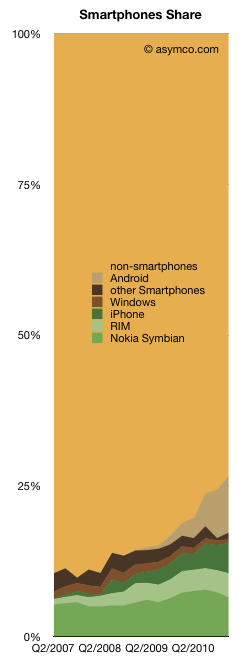
Dediu compiled second quarter smartphone market figures for the past four years (see chart at right), which makes it easy to see just how much potential is left untapped among dumbphone users. His data shows that smartphones now account for 27 percent of phones shipped to retailers.
[aditude-amp id="flyingcarpet" targeting='{"env":"staging","page_type":"article","post_id":260307,"post_type":"story","post_chan":"none","tags":null,"ai":false,"category":"none","all_categories":"business,mobile,","session":"A"}']“What the chart shows is that Android (and phone versions of iOS) have taken share from direct competitors but have taken more from non-consumption,” Dediu writes. “Rather than focusing on rivalry between platforms, minds should be focused on the shape of the smartphone adoption curve.”
Looking at the smartphone market in that light, there definitely seems to be room for entrants aside from Google and Apple to make their mark. For example, even though Microsoft’s Windows Phone 7 devices may not be selling like hotcakes yet, there’s potential for the platform to explode if it can properly tap dumbphone users (that definitely seems to be the angle with its Windows Phone ad campaign). Microsoft’s upcoming partnership with Nokia to create flagship Windows Phone devices could help in this respect.
AI Weekly
The must-read newsletter for AI and Big Data industry written by Khari Johnson, Kyle Wiggers, and Seth Colaner.
Included with VentureBeat Insider and VentureBeat VIP memberships.
But it’s definitely not going to be easy for Microsoft, or any other modern smartphone newcomer, to entice dumbphone users. In addition to powering high-end smartphones, Android is well positioned for dumbphone consumers, since it’s versatile enough to run on low- and mid-range hardware.
Research firm Gartner also released its latest mobile device numbers today, which gives us a more granular look at the state of the industry. Smartphones accounted for 23.6 percent of phones sold in the second quarter (compared to last year), according to Gartner, which falls in line with Dediu’s smartphone shipment statistics. Gartner’s numbers show that over 100 million smartphones were sold in the last quarter out of a total of 428 million mobile devices.
Additionally, the firm says that only 1.6 million Windows Phone 7 devices were sold last quarter. That’s a tepid response, for sure, but it’s definitely not enough to scare Microsoft off of smartphones. As I’ve previously argued, Microsoft is in the smartphone market for the long haul with Windows Phone, and I suspect it will work even harder to target dumbphone users over the next year.
VentureBeat's mission is to be a digital town square for technical decision-makers to gain knowledge about transformative enterprise technology and transact. Learn More